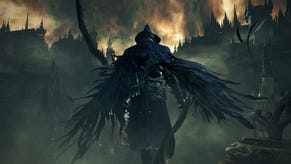Rise of the Tomb Raider Xbox One Review: Slow Rise
The long-running series continues to search for its place in the modern gaming world, with mostly great results.
This article first appeared on USgamer, a partner publication of VG247. Some content, such as this article, has been migrated to VG247 for posterity after USgamer's closure - but it has not been edited or further vetted by the VG247 team.
Just as there's a thin line between archaeology and theft, the Tomb Raider series—starring archaeologist/adventurer/thief Lara Croft—has always balanced a precarious blend of innovation and pilfering.
The entire series got its start when some folks at Core Design essentially decided to smash together Prince of Persia and Indiana Jones to see what would happen. That said, however, Tomb Raider wasn't simply a mix of those two existing properties. It threw in a third dimension to the formula as well, creating an evolutionary track for the 3D platform action genre that ran parallel to Super Mario 64, and arguably has outlasted Mario's format. Core also had the savvy to swap out their original leathery hero in favor of a curvaceous lady with bee-stung lips and a tough-as-nails attitude.

The resulting game felt at once incredibly derivative and totally fresh. And, as I touched on in last week's Retronauts, this twin tradition of innovation and imitation has remained a key element of Tomb Raider's DNA through the years. Across multiple console generations, multiple developers, and even multiple reboots, the Tomb Raider games exist in a perpetual state of one-upmanship with Prince of Persia, its offspring Assassin's Creed, and the modern-day claimant to the throne, Uncharted.
The franchise's longstanding tradition of totally swiping from everyone else creates an interesting philosophical question about the latest of Lara Croft's adventures, though. The Xbox-exclusive Rise of the Tomb Raider absolutely soars when it's simply being Tomb Raider, and it's honestly sort of dreadful when it's trying to be some other game. But since trying to be like other games has been Tomb Raider's thing since the very beginning, aren't the discordant sequences where Rise struggles to outdo the Uncharted franchise (among others) also quintessentially Tomb Raider?
Perhaps, but even so it's impossible to deny the divided, contradictory nature of Rise's design. Square Enix initially sold the game on the concept of Lara seeking therapy to deal with the trauma of the events of the first game, but after more than 20 hours with this sequel I've yet to see any hint of Lara truly struggling to come to terms with the savagery and supernatural horror of her first adventure. If Rise has a psychological element, it's about her working through her relationship with her late father by attempting to uncover the reality of the crackpot claims he made regarding lost civilizations and a "divine source." As usual, the Tomb Raider franchise walks carefully in the footsteps of its inspiration in this regard: Any movie buff will recall Indiana Jones' tense relationship with his own father, though in this case there's no opportunity for reconciliation with the deceased Lord Croft; merely catharsis. But if Rise falls decidedly short when it comes to exploring Lara's emotional scars and psychological trauma, the game itself more than makes up for it with the constant struggle of its split personalities.
On one hand, you have a truly fantastic modern take on classic Tomb Raider, with vast spaces to explore and complex puzzles to solve. This portion comprises the overwhelming majority of Rise, and for the first time since Tomb Raider: Anniversary, developer Crystal Dynamics has perfectly nailed the exploratory essence that made the older Tomb Raiders so great. Rise sticks closely to the general formula and mechanics of 2013's Tomb Raider, reprising practically every system from base camps to hunting animals for resources. But even as it copies elements of the previous game almost verbatim (including another scene where Lara walks into an enemy base only to be ambushed by soldiers with flood lights shouting "Light her up!"), it subtly refines them into something that feels more distinct from the Uncharted series.
Most of Rise centers on a handful of large, persistent spaces packed with story objectives, hidden secrets, and optional missions. It's similar to TR13 in that sense, but these areas feel larger, more substantial, and more complex. I literally spent an entire day in a sprawling Siberian base and the surrounding environs, happily completing a variety of side missions and trying to unravel all its hidden secrets before moving on... and even then, I only managed to complete about two-thirds of that region's tasks before remembering I had a review to write and getting on with the quest. I'm still a ways from completing the main story, but this is a review-in-progress not because the main story is so enormous and involving. Rather, Rise offers so much to do surrounding the main story.
In fact, Rise's plot isn't even all that interesting. TR13 made an admirable if ultimately flat attempt to depict Lara as an innocent thrust into lethal action by terrible circumstances, but Rise doesn't really bother with all that. Aside from Lara's references to loss and hardship, and the looming shadow of her father's disgrace and death, Rise more or less focuses on a straightforward adventure/conspiracy theory involving a thinly veiled stand-in for the Knights Templar—that Indiana Jones/Assassin's Creed inspiration at work again—which is perfectly functional for spurring her into action but doesn't dig with any particular enthusiasm into the question of what makes her tick. And that's fine, because the world in which this business as usual transpires is gorgeously realized.
Rise of the Tomb Raider uses a somewhat open-world format that offers plenty of opportunities to explore and run freely, but the openness has been tempered with finite boundaries. This is no Elder Scrolls or Fallout game; its environments aren't even as big as those of the latest Assassin's Creed. That works to the game's advantage, as each of the big central areas demonstrates tremendous attention to minute detail. These are designed environments, compact spaces with something to do around every corner. It's not particularly realistic, and you'll find your freedom is often restricted by gear and skill limitations, but Rise manages to achieve something much more important than intense realism or total freedom: It manages to be fun.

Perhaps no other element of the game better embodies the consideration poured into Rise's open spaces than the way you uncover clues to hidden objects nearby. Many open-world games use the Assassin's Creed system in which you claim a vantage point or acquire map data and suddenly have comprehensive information available on every item of interest in sight. In Rise, however, the points where you collect information are broken up and scattered, and finding revelatory items like explorer maps or ancient monoliths only parcels out data on a handful of secrets. While you gain insight into some hidden side objectives through this method, Rise demands actual exploration. It never degenerates into a routine of "find the control point, unlock map icons, systematically go from icon to icon; repeat."
I also appreciate the fact that Rise starts you off with many of the skills Lara acquired on her previous adventure. You don't have to go through the motions of learning how to use zip lines or scale porous rock walls again; she can do that from the beginning. Instead, the skill-building process revolves around acquiring weapons on this journey and crafting upgrades for them. Lara's learning process has more to do with her background as an avid student of history, and as such Rise is guaranteed to be the only game you'll play this year where you'll want to grind experience for greater proficiency in reading ancient Greek. Admittedly, many advanced weapons and techniques are gated behind arbitrary "because the game says so" moments; even though you acquire the tools for crafting Molotov cocktails early on in the game, you're not allowed to actually make them until you come to the cut scene where Lara decides, "Oh, I should make a Molotov cocktail." Despite the artificiality of some of these points of progression, though, Rise builds on TR13 in a satisfying manner.
And the, of course, there are the tombs. While the hub areas tend to be fairly straightforward in terms of navigation, each one contains multiple "challenge tombs." These optional sequences pose a classic Tomb Raider challenge with intricate, puzzle-like design—in fact, simply finding the entrance to many of the challenge tombs is a puzzle in and of itself. These areas of the game are far more numerous, and far more intricate, than similar features in TR13. Although the most devout of classic Tomb Raider diehards will probably never find peace in the series' newfound devotion to more accessible navigation and world design, the challenge tombs offer a very convincing make-good.
Sadly, then, in light of all the things Rise of the Tomb Raider does so well, its shortcomings chafe all the more.
As much as Rise's central design philosophy truly feels like a modern-day expression of the creative drive behind the original Tomb Raiders, the brief, flashy sequences that connect the portions of the main story together feel like the results of a dire lack of confidence. This isn't new to the series, exactly—QTEs have been a part of Tomb Raider ever since Anniversary's misguided attempt to turn the terrifying T-rex encounter into an exercise in timed button-pressing—but here it feels more out of place than ever. The action and exploration in Rise work so well, and comprise so much of the overall experience, that the "interactive" cutscenes that drive the story become jarring.
I assume the thinking behind the inclusion of heavily scripted sequences is to help key story moments stand out from the rest of the experience, but the end result is that they stand apart so much they almost seem to be part of some other game. It doesn't help that they're so poorly designed. Many of Rise's QTE cut scenes suffer from awkward camera angles or oblique objectives, guaranteeing a failure and a restart. In several cases early on, these cutscenes actually introduce new mechanics that you've never seen before, forcing you to repeat the same mundane actions (each attempt complete with several seconds of reloading) until you lock down the timing. As a result, sequences presumably intended to liven up the experience instead break it up, undermining the game's pacing and afflicting crucial story moments with a stultifying stop-start rhythm.
To Rise's credit, you have to deal with far fewer of these flashy moments than in TR13. But they still bog down the central plotline, and they ultimately serve to make the main quest line feel like a completely different game than the rest of Rise. It suggests a lack of confidence in the fundamental excellence of the bulk of the game, or perhaps a lack of confidence in the audience's ability to be engaged by anything other than the most rote, trial-and-error game design. But Tomb Raider doesn't work when it's trying to be Uncharted, and the frustrating irony is that Rise has several sequences that manage to create a sensation of tension and plot importance without resorting to stripped-down button-tapping banality.
At one point, Lara becomes embroiled in a small war, which happens all around her despite and propels the storyline even though the player only engages in a few skirmishes during this battle; the visual and audio design convey the carnage surrounding Lara despite her being isolated from the bulk of the action. Despite being little more than an alternate graphical skin for a routine combat sequence, this conflict is one of the most intense portions of the entire game—and all without a single QTE. Instead, it hits hard because of the dramatic audio and visual design unique to that portion of the game, and because the narrative builds up to the battle for several hours.

This fantastic sequence also underscores the reason this review isn't complete yet. Although I have an excellent grasp of both the strengths and weaknesses of Rise at this point, I need to see if that explosive, fiery battle is a sign of great things to come. TR13 became more and more bogged down with asinine GTEs and clichéd scripted action sequences as you approached the end, and Rise could very well end up going in that direction as well. I hope it doesn't, though. Tomb Raider may have been built on a foundation of borrowing ideas from other games and developers, but the series has long since established itself, and Rise proves it: It's great when it's brave enough to be itself, and not so great when it's trying to be some other game.
Post-game thoughts and conclusion
Tomb Raider has struggled to find its identity from the very first sequel. Yes, the series is synonymous with Lara Croft for all intents and purposes, but what about the gameplay? The story? The structure? In what configuration do these things add up to "Tomb Raider"?
Rise of the Tomb Raider deserves notice because it's a first for the franchise in its nearly 20 years of history: A sequel that feels more confident in itself than its predecessor. The original 1996 Tomb Raider offered a no-fat experience, a massive journey through a seemingly endless procession of puzzles and traps, and with each iteration of the Tomb Raider concept the series moves further and further from that simple template. Rise, to me, feels like the first time the series has moved back toward the spirit of '96 rather than further from it.

By no means is this as heavily puzzle- and exploration-oriented a game as the old PlayStation games or even Tomb Raider: Anniversary. Lara—or rather, developer Crystal Dynamics—continues to suffer from a profound identity crisis. Rise doesn't perfectly solve the question of "what is Tomb Raider?", because many of the answers contained herein don't fit together well. Rise's design consists of four parts: Third-person combat, set piece events, sandbox exploration, and puzzle navigation. The two latter elements work brilliantly and feel very much in keeping with Lara's history; the two former elements, on the other hand, don't quite gel. Unfortunately, they comprise much of the mandatory path through the game.
2013's Tomb Raider took considerable flack for failing to live up to its name. It offered few opportunities to work your brain muscles and solve interesting environmental puzzles; the small amount of tomb raiding present had been quarantined to a handful of simple "challenge tombs," all of which felt laughably brief and simplistic. Rise brings back these optional areas, and this time they appear in greater numbers and actually feel worthy of the name. Rise contains nearly a dozen challenge tombs, and they vary in complexity from "moderate" to "baffling." They can take anywhere from 10 to 30 minutes to complete and require plenty of experimentation and exploration—especially since you can't press the "survival instinct" button for an instant solution the way you can throughout the rest of the game.

These areas are strictly optional—it says so right there in the name—but Crystal Dynamics makes them incredibly enticing. Not only do the puzzle dungeons feature the game's most involving design, they also dole out invaluable rewards. Rather than just handing Lara cash or trinkets or better weapons (which do appear frequently in the challenge tombs), reaching the end of these labyrinths will lead you ancient documents that will teach Lara long-lost combat and survival techniques. In other words, solving these challenges gives you a significant advantage in the action portions of the game.
Challenge tombs usually feature elaborate mechanisms, frequently involving the raising and lowering of water levels, and their overall vibe calls back strongly to the best moments of Core Designs' classic Tomb Raider games. At the moment, I'm trying to puzzle my way through these dungeons as part of my post-game mop-up and am stuck in an ancient bath. Between the enigmatic design and the rusty color palette, it genuinely feels like a chunk of Tomb Raider II transplanted into the modern Tomb Raider framework. I have no idea what I'm supposed to do to proceed at the moment, but I'll figure it out... and I love it.
But that's the problem with Tomb Raider, right? This project clearly had a hefty price tag attached: It looks gorgeous, yet it's also expansive, complex, and packed with a variety of game systems. As we've learned over the past few years, big-budget game developers don't stay in business by catering to the niche, and Tomb Raider can only survive in this form by appealing to as many people as possible. You don't win millions upon millions of hearts and minds by throwing obstructions in their path, bringing the game to a grinding halt, and forcing them to solve an elaborate 3D puzzle that demands lengthy consideration. The intricate dungeon design that once defined Tomb Raider has become anathema to the series' viability.

In that light, I'm impressed by the fact that Rise actually does contain a few meaty dungeon areas along the critical story path that do tap into that classic spirit. There's one area in particular, late in the game, that involves rolling explosive barrels into place in a crumbling cistern, which truly plays like a modern-day rendition of the Tomb Raider that once was. It's brief, and you can use the survival instinct mode to have the game basically walk you through the puzzle, but it's much more of a classic Lara Croft scenario than anything in 2013's game. Granted, it's followed immediately by yet another of those QTE-like trial-and-error action sequences where the world explodes around Lara and have to dash to safety (see also: basically every action game since the first Uncharted). But it's far from the only time Rise throws a stumper along the main path, and the overall game feels much richer for the variety.
The downside to this is that the slower-paced sequences lend to the uneven feeling of the game as a whole. Lara's story path leads her through a handful of tricky puzzles, but generally speaking the mission-critical portions consist of shootouts and pseudo-QTEs. There's nothing inherently wrong with these elements, but at the same time nothing about them particularly stands out, either. Rise features neatly polished third-person shooting mechanics, but they're indistinguishable from the shooting mechanics in countless other games. Aside from a couple of small details relating to archery (poison arrows are the game's secret MVP), Rise's shootouts could have been lifted straight from a dozen other games as she scrambles for cover, zooms in for headshots, and uses melee finishers to take out foes up close.
Rise rarely does anything interesting with its combat. It's wave after wave of identical, balaclava-clad soldiers that come in four basic types; later, you face a different kind of enemy, but they aren't too terribly distinct from the soldiers and also come in four similar basic types. Standout sequences like the one where Lara basically plays the role of movie monster, lurking underwater and quietly picking off soldiers one by one, appear far too rarely. The action grows monotonous toward the end, as the final few hours of the game consist of practically nothing but gunplay, culminating in a frustrating, gimmicky shootout with basically an entire army. This is followed by another one of those godawful final battles that changes all the rules of combat rather than putting the skills you've mastered over the past 20 hours to the test.

Compounding the problems with all this late-game combat is how the endless gunplay sits at odds with the story. Lara's meant to be a determined if reluctant survivor, not the Terminator, but she singlehandedly takes out an entire army and effortlessly deals with bizarre supernatural threats that are supposedly legendary in their power and ruthlessness. Stealth plays a part in the action, but only to a point, whereas the whole thing really should play as a stealth game. Lara as silent predator is brilliant; Lara as indestructible warrior who can take a shotgun blast to the face and keep on going, not so much.
The one redeeming thing about the constant gunplay that characterizes the final stretch of the action is that you only have to suffer through it once. Players who go back to seek 100% game completion don't have to wind back to an old save but rather can play through these areas after the central conflict is resolved. There are still enemies to deal with, but they're fewer in number and don't require much effort to wrap up or avoid altogether.
All told, Rise of the Tomb Raider feels like an attempt to walk things back a few steps, and it largely succeeds. The 2013 reboot told an interesting story about Lara's origins but framed it in a by-the-numbers modern action game. Rise tells a less interesting tale, but the game surrounding it does a much better job of differentiating itself from its peers—when it offers more than an endless hallway of cover-based shooting, that is. There's room for both exploration and action in the Tomb Raider series, but Rise excels at the former while the latter remains entirely rote. The game's post-credits coda establishes Crystal Dynamics' intentions for a sequel, and I'm absolutely looking forward to that follow-up. I just hope that next time around, the shooting and combat elements either live up to the high bar that Rise has set for everything else that is modern Tomb Raider... or else take a back seat to the parts that make Lara Croft Lara Croft.
InterfaceMostly standard fare for third-person action games. The unique controls, such as the grappling hook, double up with other commands, and sometimes the game gets confused about which you're trying to execute.
Lasting AppealRise includes four or five massive sandbox areas packed with bonus tombs, side missions, and even unlisted challenges. There's a lot of game here.
SoundAbout what you'd expect—solid voice acting, eerie environmental effects, rousing music.
VisualsOne of the best-looking games I've ever played, bar none, with a huge variety of environments rendered in beautiful detail.
ConclusionIn a way, Rise of the Tomb Raider lives up to its name: You can see the classic Tomb Raider elements rising up through the clichés of modern-day third-person action games. The two facets of Rise's design never quite learn to live in harmony, but at least the elements that feel unique to the Lara Croft franchise appear far more prominent than in the 2013 game. There's far too much predictable, uninspired gunplay, but despite its mandatory nature it still comprises only a tiny portion of the overall game experience. Tomb Raider hasn't quite found its voice in modern gaming... but it's getting there.










